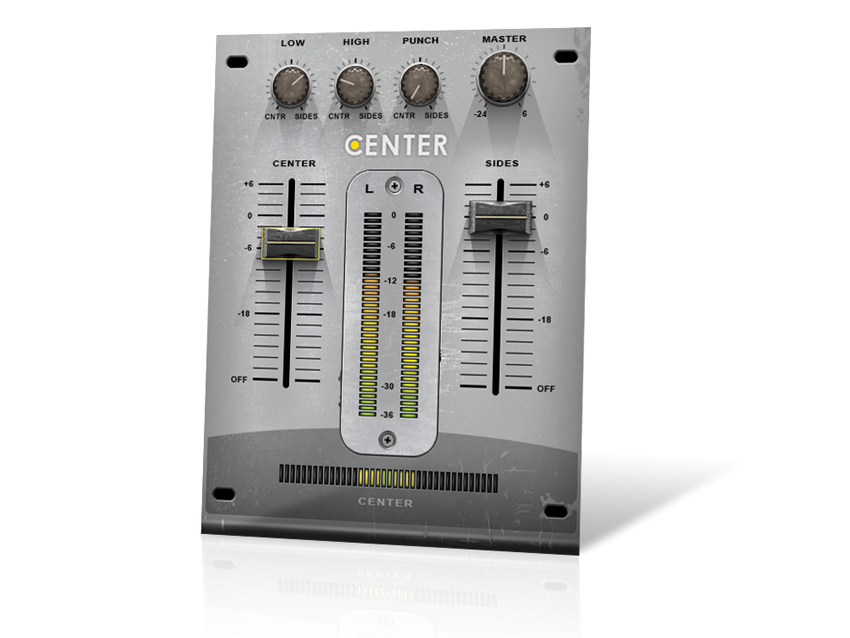MusicRadar Verdict
Although it's not a must-buy, Center offers a refreshing take on stereo tinkering and is up to Waves' usual high standards.
Pros
- +
Simple interface. An unusual take on stereo manipulation. Has varied uses. Sensible processing parameters.
Cons
- -
Expensive. No balance/pan functionality. Workings not entirely explained!
MusicRadar's got your back
In recent times, quality mid/side plug-ins from the likes of BrainWorx have reignited the 'sum and difference' debate.
At first glance, it might seem that plug-in giants Waves is also entering M/S territory, but Center is actually a pretty different take on stereo image manipulation, combining a clean, simple interface with a novel processing technique.
Summary
Underlying the whole thing is a signal splitter that extracts the phantom centre channel and enables re-balancing of the centre and sides. It seems to use similar processing techniques to the Center Channel Extractor in Adobe Audition 3, with Waves' manual describing a program-dependent dynamic process based on the amplitude, frequency and time envelope of the original material.
Most DAWs have 'utility' plug-ins that enable you to isolate the sum and difference (ie, mid and side) elements of a stereo signal. The sum is simply a mono mix - ie, left and right signals added together.
The side signal contains the stereo information and is isolated by subtracting one channel from the other - even with a mix containing centre-panned drums and guitars panned hard left and right, the guitars will be very much present in the mid signal.
Waves Center is different, and as they say, the middle here is the 'phantom' or perceived centre, rather than just a mono sum. The nearest we could get to an M/S middle signal was with the High and Low knobs set to Centre and the overall centre-channel balance turned up.
Interestingly, even with the controls set lat on Center, the signal is still affected, as confirmed by comparing it to the dry, unprocessed version.
Suggested uses of Center include rebalancing central and side elements in any stereo mix, and even completely removing mono aspects, such as vocals, from a track. The main level controls (centre, sides and overall master out) facilitate such use, but there are three further processing options: Low, High and Punch. These are all balance controls for shifting their respective elements to the centre or sides.
Naturally, Low and High deal with the frequency content of the respective signal elements. Punch, on the other hand, is a dynamic processor designed to emphasise the transient content in either the centre or sides signal.
Staying with the vocal removal example, Waves suggests you can use this control to restore lost transients by turning the Punch control towards the sides.
In use
First impressions are that Waves Center provides a quick route to rebalancing the levels of central and side elements of a stereo signal. Soloing the two components (by turning the fader of one right down - there are no solo/mute buttons) and tweaking the various parameters makes it apparent that any change to the centre has a corresponding effect on the sides, and vice versa.
What's more, while the Low and High controls are static in their nature, the Punch control is most definitely dynamic, and has the greatest overall impact on the results.
As we've said, Waves suggests using Center to reduce the level of, or remove, vocals (which are typically panned centrally). It's reasonably effective at this, although you'll still be able to hear the remaining stereo aspects, such as reverb. Conversely, there's nothing to stop you using Center to push up a vocal that's too quiet.
Having established that Center is more of a processor than a straightforward utility plug-in, you may be less inclined to use it for everyday mastering. Still, we found that, by treading carefully, we could subtly enhance stereo mixes and sub-mixes very successfully.
We also discovered that the Punch control was useful for modifying and processing individual stereo sounds, widening or narrowing the dynamics, and generally fiddling with the stereo image.
We must highlight that there are no left/right balance controls for sorting out wonky stereo images, but overall, once we got used to the way it works, Center proved to be simple to use and rewarding.
Hear Center at work on a piano, snare drum and acoustic guitar:
Computer Music magazine is the world’s best selling publication dedicated solely to making great music with your Mac or PC computer. Each issue it brings its lucky readers the best in cutting-edge tutorials, need-to-know, expert software reviews and even all the tools you actually need to make great music today, courtesy of our legendary CM Plugin Suite.

“This is a beautiful, well-executed Les Paul, and that’s the sort of guitar you tend to hold onto for life. That’s as sound an investment as there is”: Gibson Les Paul Standard ‘50s Double Trouble review

“We were able to fire up a bass sound that was indistinguishable from the flavour of New Order’s Blue Monday in seconds”: EastWest Sounds Iconic review

“How long did it take me to get over it? Oh, quite a while”: Brian May on the “supreme injustice” of Roger Taylor’s Queen B-side "making as much money as Bohemian Rhapsody"









